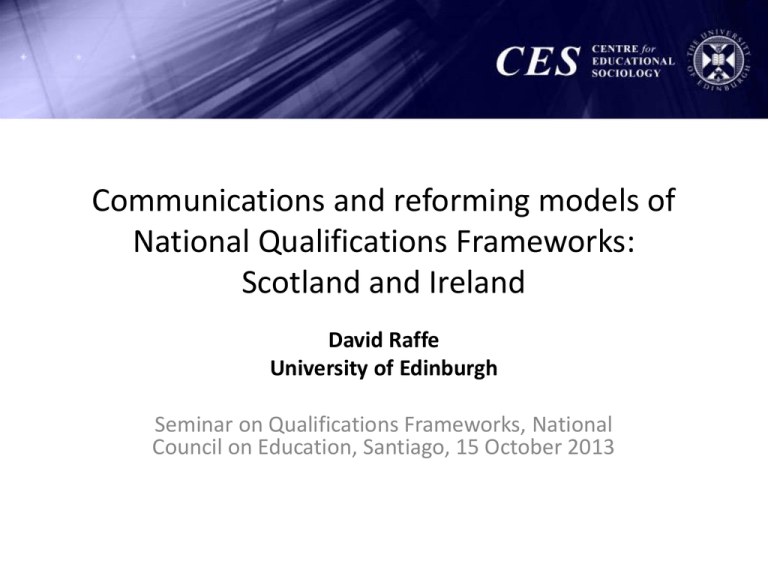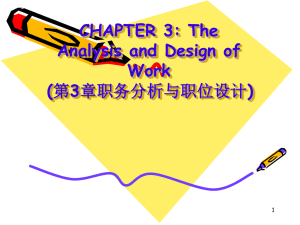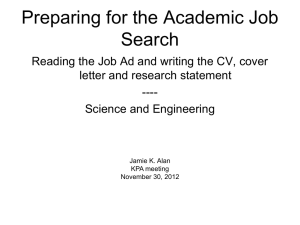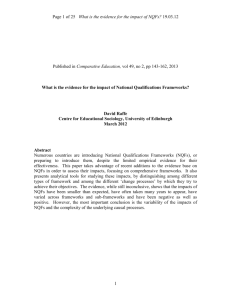Communications framework - University of Edinburgh
advertisement

Communications and reforming models of National Qualifications Frameworks: Scotland and Ireland David Raffe University of Edinburgh Seminar on Qualifications Frameworks, National Council on Education, Santiago, 15 October 2013 Overview 1. A conceptual framework: National Qualifications Frameworks (NQFs) and how they differ 2. The Scottish Credit and Qualifications Framework (SCQF): a communications framework 3. The Irish National Framework of Qualifications (NFQ): a reforming framework 4. Some concluding comments 1. A conceptual framework: National Qualifications Frameworks and how they differ What is a Qualifications Framework? A qualifications framework is an instrument for the development and classification of qualifications according to a set of criteria for levels of learning achieved.... The scope of frameworks may be comprehensive of all learning achievement and pathways or may be confined to a particular sector.... Some frameworks may have more design elements and a tighter structure than others; some may have a legal basis whereas others represent a consensus of views of social partners. All qualifications frameworks, however, establish a basis for improving the quality, accessibility, linkages and public or labour market recognition of qualifications within a country and internationally (OECD 2007) How NQFs differ • National context – size of country, policy culture, expertise, education system, labour market, concept of qualification • Scope – sector v comprehensive; over-arching framework v sub-frameworks • Design – number of levels, descriptors, fields, credit, tight v loose, role of learning outcomes • Leadership and control – roles of stakeholders, regulatory v voluntary, ‘top-down’ v ‘bottom-up’ • Purposes and how NQFs try to achieve them … Possible purposes of NQFs To improve understanding of learning system To increase coherence and coordination To promote access, transfer and progression To recognise existing skills To provide instrument of accountability and control To update and extend standards and make them more consistent To enhance quality of learning To make education more demand-focused To promote mobility To link national qualifications to trans-national framework Possible change processes: how NQFs may try to achieve their purposes A common ‘language’ Stakeholder engagement and coordination Regulation Quality assurance Unitisation Making individual qualifications more transparent (eg through learning outcomes) Cultural change Choice may depend upon - National context: governance, culture, etc - Time scale Three types of NQF • Communications framework: starts from existing system, describes it, aims to make it more ‘transparent’ and support rationalisation and coherence; a tool for change rather than a driver of change • Reforming framework: starts from existing system, aims to make it more transparent but also to achieve specific reforms, e.g. fill gaps, improve quality, update standards • Transformational framework: starts from desired future system, aims for radical change, driver of change as well as tool for change … or a continuum of NQFs Communications Transformational Describe Prescribe Existing system Future system Tool for change Driver of change Loose design Tight design Outcome-referenced Outcomes-led Voluntary Regulatory … but … • An NQF may vary across its ‘sub-frameworks’ and between sub-frameworks and over-arching framework • An NQF may change over time 2. The Scottish Credit and Qualifications Framework (SCQF): a communications framework Scotland: the national context • • • • Separate system within UK Small country, uniform institutions Policy-making culture Earlier reforms developed ‘sub-frameworks’ – Higher education degrees – Schools and colleges qualifications (Scottish Qualifications Authority) – Competence-based occupational qualifications (SVQs) … which established much of architecture of future framework • Pressures for more unified system • Choice of ‘communications’ NQF A communications NQF : describing the existing system Scottish Credit and Qualifications Framework (SCQF) • Design: comprehensive, links sub-frameworks; ‘loose’; 12 levels; level descriptors for 5 ‘characteristics’ of outcomes; credit • Purposes: to make system easier to understand; to promote access and progression • Change processes: common language, unitisation, engaging stakeholders SCQF: Implementation • Formal launch 2001, implementation from 2003 • Voluntary framework, led by ‘owners’ of qualifications sub-frameworks (including universities) and quality body • Other organisations can also become ‘credit-rating bodies’ and admit qualifications to the framework • Implementation slow – especially non-mainstream qualifications • Partnership strengthened in 2007 • But framework has retained stakeholder support SCQF: Uses • Uses include: – Programme development, planning and managing educational provision – Coordinating provision across institutions and sectors – Supporting access, progression and credit transfer – Recognition of prior learning – Guidance – Human resource management • Slow to realise potential uses – still greater than actual uses • A ‘useful tool’ – whose use depends upon other drivers SCQF: Impacts and issues • Broadly successful but – Aims were modest – Built on (more radical) earlier reforms • Much of impact achieved by becoming ‘national language’ – promotes coherence • More impact in education than in labour market • Barriers to a unified framework: – Different types of learning – Institutional barriers – Political barriers • Needs to be part of a broader policy strategy 3. The Irish National Framework of Qualifications (NFQ): a reforming framework Ireland • Small country, uniform institutions • Policy community • Emerging ‘sub-frameworks’ for: – – – – • • • • Universities Non-university higher education General education (schools) Further education and training Pressures for more coherent system Pressures for reform within sectors … European influence – especially HE Choice of ‘reforming’ framework A reforming NQF: describing the existing system and driving specific reforms • Design: comprehensive; loose; 10 levels; descriptors for knowledge, skills, competence; award types; guidelines for quality assurance and for access transfer and progression; regulatory within 2 sectors • Purposes: broader than Scotland: (also) raising standards, enhancing quality, changing culture • Change processes: broader than Scotland: (also) regulation, quality assurance, cultural change NFQ: Implementation • Formal launch 2003 • Built on earlier and continuing reforms • Initially led by single Authority & separate awards councils for each sub-framework • Merged into single body in 2012 – now more emphasis on integration across sub-frameworks? • Stakeholder engagement NFQ: Issues • Reasonably successful – given more ambitious aims and different starting point than Scotland – but • Implementation and impact slow … • … and variable across sectors; less in general education • Competing philosophies of NQF and educational selection • Slow to integrate sub-frameworks • Concerns that many changes have been superficial • ‘Anomalies’ in placing existing qualifications • Impact needs strong ‘drivers’ (funding, public recruitment) • More impact in education than labour market 4. Concluding comments General model of change An NQF is a social construct and not just a technical instrument: it is about trust, understanding, culture and pragmatic compromise. The introduction of an NQF requires • Long time scales • Stakeholder involvement and partnership • A loose but variable design • ‘Iterative alignment’ of NQF and practice • Balance development within sub-frameworks and integration across them erience) • ‘Policy breadth’ – to be part of a broader policy programme Possible Issues for Chile • What objectives? For which sectors? • Will they change? What is the time scale? • How would the objectives be achieved? (Which ‘change processes’ would work in Chile?) • Priorities: development within sectors or integration across them? • Is there the will to join voluntarily in a non-regulatory ‘unifying framework’? How to create it? • Are employment stakeholders equally engaged? • Does Chilean higher education speak with a single voice (enough to share the leadership?) • What is the broader policy/reform programme? Thank you for your attention David.Raffe@ed.ac.uk Some references CES Briefings. http://www.ces.ed.ac.uk/publications/briefings.htm Collins, T., Kelly, F., Murdoch, H., Raffe, D. and Murphy, A. (2009) Framework Implementation and Impact Study: Report of Study Team. Dublin: National Qualifications Authority of Ireland. European Training Foundation, CEDEFOP and UNESCO (2013) Global NQF Inventory https://lnconnections02.etf.europa.eu/activities/service/html/mainpage#activitypage,FFFG22d8f11eac534299 91307645a2765038. Howieson, C. and Raffe, D. (2013) The paradox of Scotland: limited credit transfer in a credit-based lifelong learning system. Oxford Review of Education. DOI: 10.1080/03054985.2013.806250. International Labour Organisation. ILO research programme on implementation and impact of NQFs. http://www.ilo.org/skills/projects/WCMS_126588/lang--en/index.htm Raffe, D. (2011) Are ‘communications frameworks’ more successful? Policy learning from the Scottish Credit and Qualifications Framework. Journal of Education and Work, 24, 3-4, 283-302. Raffe, D. (2011) The role of learning outcomes in National Qualifications Frameworks, in Bohlinger, S. and Münchhausen, G. (eds) Validierung von Lernergebnissen: Recognition and Validation of Prior Learning. Bielefeld: Bertelsmann. Raffe, D. (2013) What is the evidence for the impact of National Qualifications Frameworks? Comparative Education, 49, 2, 143-162.








